Grain-to-Grain Interaction Effect in Polycrystalline Plain Low-Carbon Steel within Elastic Deformation Region
Abstract
1. Introduction
- (1)
- (2)
- (3)
- Sound velocity measurement test [1]: The velocity of the longitudinal wave, , depends on the Young’s modulus and the density of the bulk material, , by the equation: . The Young’s modulus is determined by the above equation, in which is measured by the experiment.
2. Materials and Methods
3. Results and Discussion
3.1. System Error of DIC Strain Measurement
3.2. Young’s Modulus and Elastic-Strain Ratio of Individual Grains
3.3. Factors Affecting the Elastic-Strain Ratio
- (1)
- Misorientation angle: In a polycrystal, each grain has its specific crystal orientation; thus, the misorientation angle is present between two adjacent grains. The misorientation angle of grain i with grain (i + 1) to grain (i + 8) is denoted as Δθi,i+1, Δθi,i+2, …, Δθi,i+8. The misorientation angle of each grain in Table 1 with its adjacent grains can be determined from the IPF map shown in Figure 3b.
- (2)
- Difference in the inherent Young’s modulus: The inherent Young’s modulus of grain i and its adjacent grains (grain (i + 1) to grain (i + 8)) is denoted as Ei, Ei+1, …, Ei+8. We take grain i and grain (i + 1) as an example. The difference in the inherent Young’ moduli of grain i and grain (i + 1) is defined as ΔEi,i+1 = Ei − Ei+1. The grain-boundary length between the two grains is Li,i+1. The difference in the inherent Young’s moduli of grain i and other adjacent grains is defined in the same way.
4. Conclusions
- (1)
- The DIC technique is a reliable tool to measure the Young’s modulus of individual grains in a polycrystal.
- (2)
- The elastic–strain ratio—defined as the ratio of the elastic strain within a grain with grain-to-grain interaction to that without grain-to-grain interaction at a given stress—is a parameter independent of the applied stress. It can be used to evaluate the degree of grain-to-grain interaction within the elastic region.
- (3)
- There is almost no constraint on the deformation of a grain whose inherent Young’s modulus is the same as the Young’s modulus of the bulk material. The grain-to-grain interaction effect is significant for a grain which has a great difference between its inherent Young’s modulus and the Young’s modulus of the bulk material.
- (4)
- The interaction of a grain with its adjacent grains is mainly caused by the difference in the inherent Young’s moduli between the grain and its adjacent grains. The greater the difference, the greater the interaction. The average of the misorientation angles between the grain and its adjacent grains have almost no effect on the grain-to-grain interactions.
Author Contributions
Funding
Institutional Review Board Statement
Informed Consent Statement
Data Availability Statement
Conflicts of Interest
References
- Ashby, M.F.; Jones, D.R.H. Engineering Materials 1: An Introduction to Properties, Applications and Design; Elsevier Ltd.: Oxford, UK, 2007; pp. 32–38. [Google Scholar]
- Masuda, H.; Morita, K.; Ohmura, T. Nanoindentation-induced plasticity in cubic zirconia up to 500 °C. Acta Mater. 2020, 184, 59–68. [Google Scholar] [CrossRef]
- Pathak, S.; Stojakovic, D.; Kalidindi, S.R. Measurement of the local mechanical properties in polycrystalline samples using spherical nanoindentation and orientation imaging microscopy. Acta Mater. 2009, 57, 3020–3028. [Google Scholar] [CrossRef]
- Sarvesha, R.; Gokhale, A.; Kumar, K.; Sharma, N.K.; Jain, J.; Singh, S.S. Effect of crystal orientation on indentation-induced deformation behavior of zinc. Mater. Sci. Eng. A 2020, 776, 139064. [Google Scholar] [CrossRef]
- Everaerts, J.; Papadaki, C.; Li, W.; Korsunsky, A.M. Evaluation of single crystal elastic stiffness coefficients of a nickel-based superalloy by electron backscatter diffraction and nanoindentation. J. Mech. Phys. Solids 2019, 131, 303–312. [Google Scholar] [CrossRef]
- Abdolvand, H.; Wright, J.; Wilkinson, A.J. Strong grain neighbour effects in polycrystals. Nat. Commun. 2018, 9, 171. [Google Scholar] [CrossRef] [PubMed]
- Lee, S.M.; Kim, J.-H.; Kim, Y.S.; Ohba, T.; Kim, T.-S. Effects of thickness and crystallographic orientation on tensile properties of thinned silicon wafers, IEEE Transactions on Components. Packag. Manuf. Technol. 2020, 10, 296–303. [Google Scholar] [CrossRef]
- Sánchez-Arévalo, F.M.; Pulos, G. Use of digital image correlation to determine the mechanical behavior of materials. Mater. Charact. 2008, 59, 1572–1579. [Google Scholar] [CrossRef]
- Tung, S.-H.; Shih, M.-H.; Kuo, J.-C. Application of digital image correlation for anisotropic plastic deformation during tension testing. Opt. Lasers Eng. 2010, 48, 636–641. [Google Scholar] [CrossRef]
- Farahani, B.V.; Amaral, R.; Tavares, P.J.; Moreira, P.M.G.P.; Santos, A.D. Material characterization and damage assessment of an AAS352 aluminium alloy using digital image correlation. J. Strain Anal. 2020, 55, 3–19. [Google Scholar] [CrossRef]
- Venkatachalam, S.; Banjare, R.; Murthy, H.; Rao, B.C. Mechanical testing of micro-specimens of Al6061-T6 using DIC for strain measurement. Exp. Tech. 2019, 43, 125–135. [Google Scholar] [CrossRef]
- Goh, C.P.; Ratnam, M.M.; Ismail, H. Large in-plane deformation mapping and determination of Young’s Modulus of rubber using scanner-based digital image correlation. Exp. Tech. 2016, 40, 1117–1127. [Google Scholar] [CrossRef]
- Cho, S.W.; Chasiotis, I. Elastic properties and representative volume element of polycrystalline silicon for MEMS. Exp. Mech. 2007, 47, 37–49. [Google Scholar] [CrossRef]
- Ivanov, E.; Ienny, P.; Léger, R.; Caro-Bretelle, A.S.; Kotsilkova, R. Strain localization in iPP/MWCNT nanocomposites using digital image correlation. Strain 2014, 50, 37–47. [Google Scholar] [CrossRef]
- He, W.; Goudeau, P.; Le Bourhis, E.; Renault, P.-O.; Dupré, J.C.; Doumalin, P.; Wang, S. Study on Young’s modulus of thin films on Kapton by microtensile testing combined with dual DIC system. Surf. Coat. Tech. 2016, 308, 273–279. [Google Scholar] [CrossRef]
- Robert, L.; Nazaret, F.; Cutard, T.; Orteu, J.-J. Use of 3-D digital image correlation to characterize the mechanical behavior of a fiber reinforced refractory castable. Exp. Mech. 2007, 47, 761–773. [Google Scholar] [CrossRef]
- Masumoto, H.; Saito, H.; Murakami, Y.; Kikuchi, M. Crystal anisotropy and temperature dependence of Young’s modulus of nickel single crystals. J. Jpn. Inst. Met. Mater. 1968, 32, 525–528. [Google Scholar] [CrossRef][Green Version]
- Hosford, W.F. The Mechanics of Crystals and Textured Polycrystals; Oxford University Press: Oxford, UK, 1993; pp. 3, 15, 16, 19, 21, 22. [Google Scholar]
- Sutton, M.A.; Wolters, W.; Peters, W.; Ranson, W.; McNeill, S. Determination of displacements using an improved digital correlation method. Image Vis. Comput. 1983, 1, 133–139. [Google Scholar] [CrossRef]
- Koohbor, B.; Ravindran, S.; Kidane, A. Experimental determination of Representative Volume Element (RVE) size in woven composites. Opt. Lasers Eng. 2017, 90, 59–71. [Google Scholar] [CrossRef]
- Tracy, J.; Daly, S.; Sevener, K. Multiscale damage characterization in continuous fiber ceramic matrix composites using digital image correlation. J. Mater. Sci. 2015, 50, 5286–5299. [Google Scholar] [CrossRef]
- Ravindran, S.; Koohbor, B.; Kidane, A. Experimental characterization of meso-scale deformation mechanisms and the RVE size in plastically deformed carbon steel. Strain 2017, 53, e12217. [Google Scholar] [CrossRef]
- Kammers, A.D.; Daly, S. Small-scale patterning methods for digital image correlation under scanning electron microscopy. Meas. Sci. Technol. 2011, 22, 125501. [Google Scholar] [CrossRef]
- Qiu, H.; Ueji, R.; Kimura, Y.; Inoue, T. Heterogeneous distribution of microstrain evolved during tensile deformation of polycrystalline plain low carbon steel. Metals 2020, 10, 774. [Google Scholar] [CrossRef]
- Hutchings, M.T.; Krawitz, A.D. Measurement of Residual and Applied Stress Using Neutron Diffraction; Kluwer Academic Publishers: Boston, MA, USA, 1992; pp. 223–231. [Google Scholar]

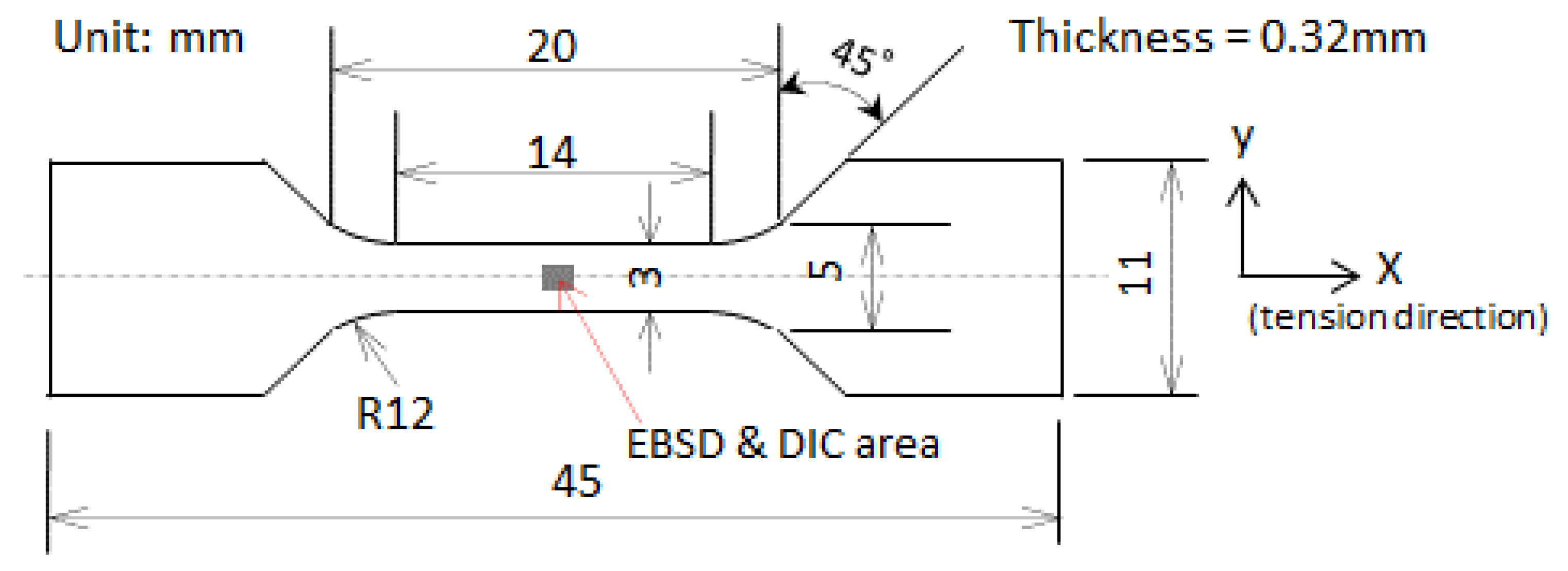
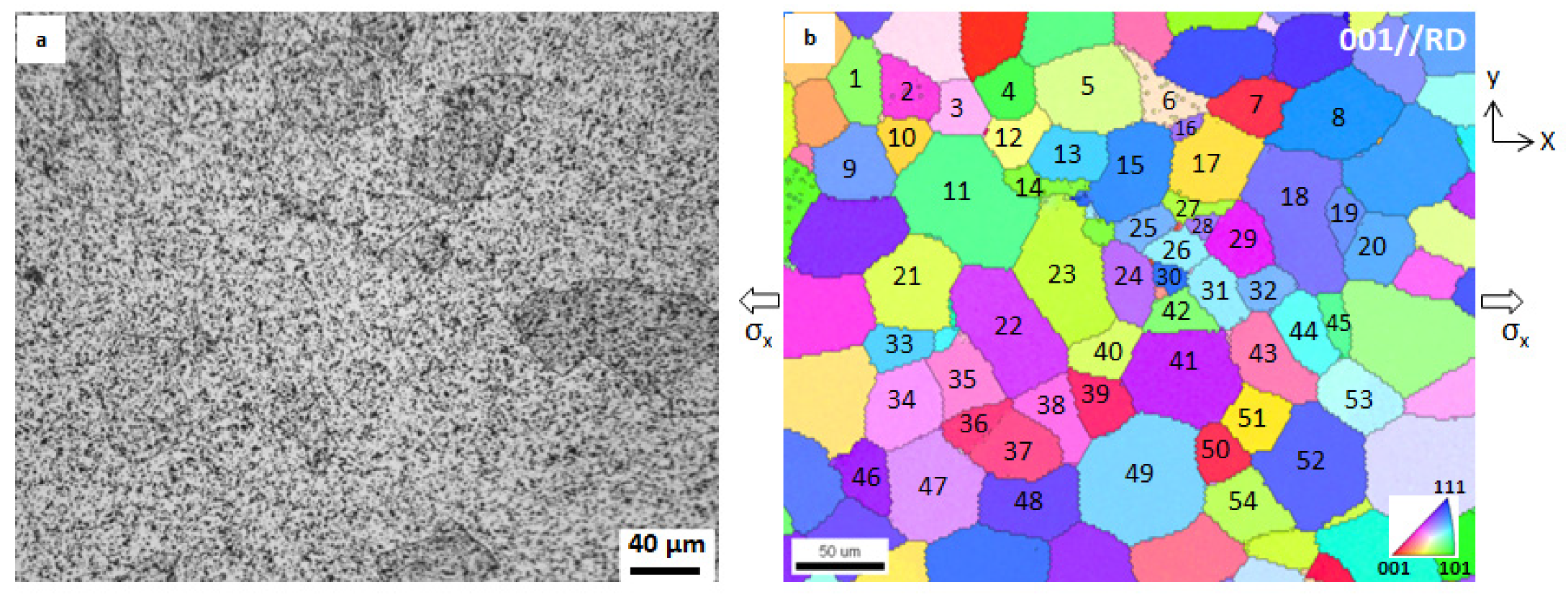
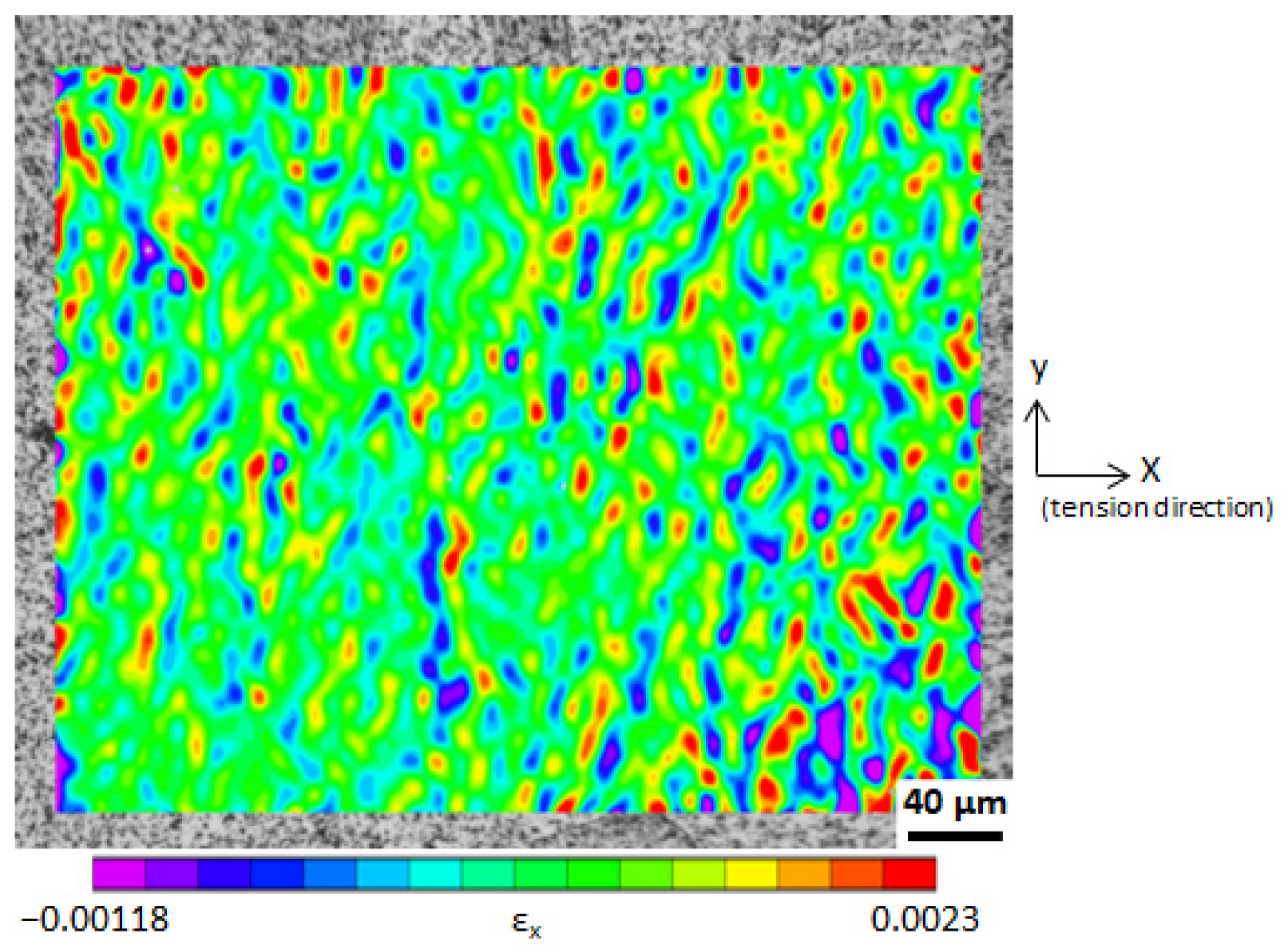
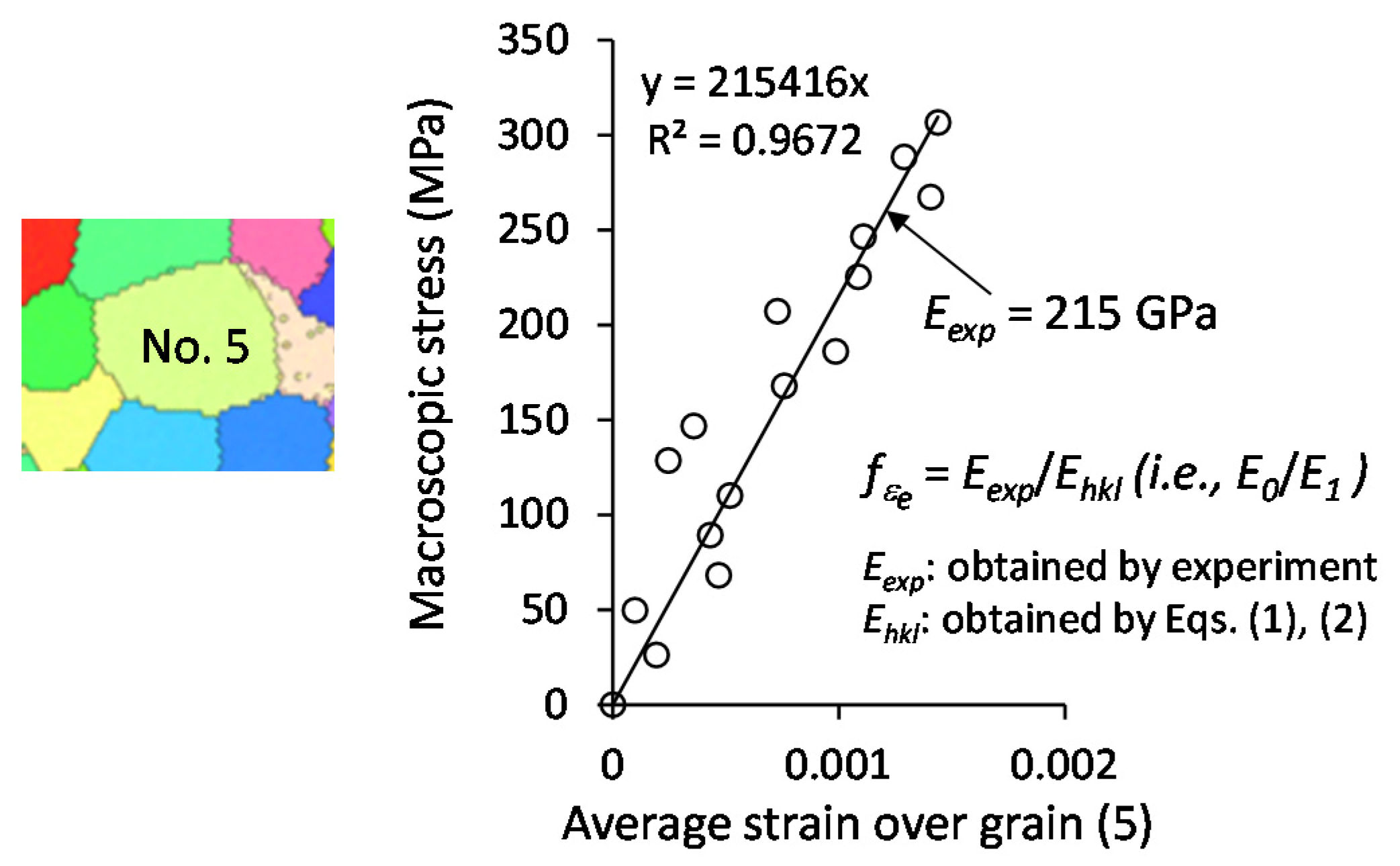

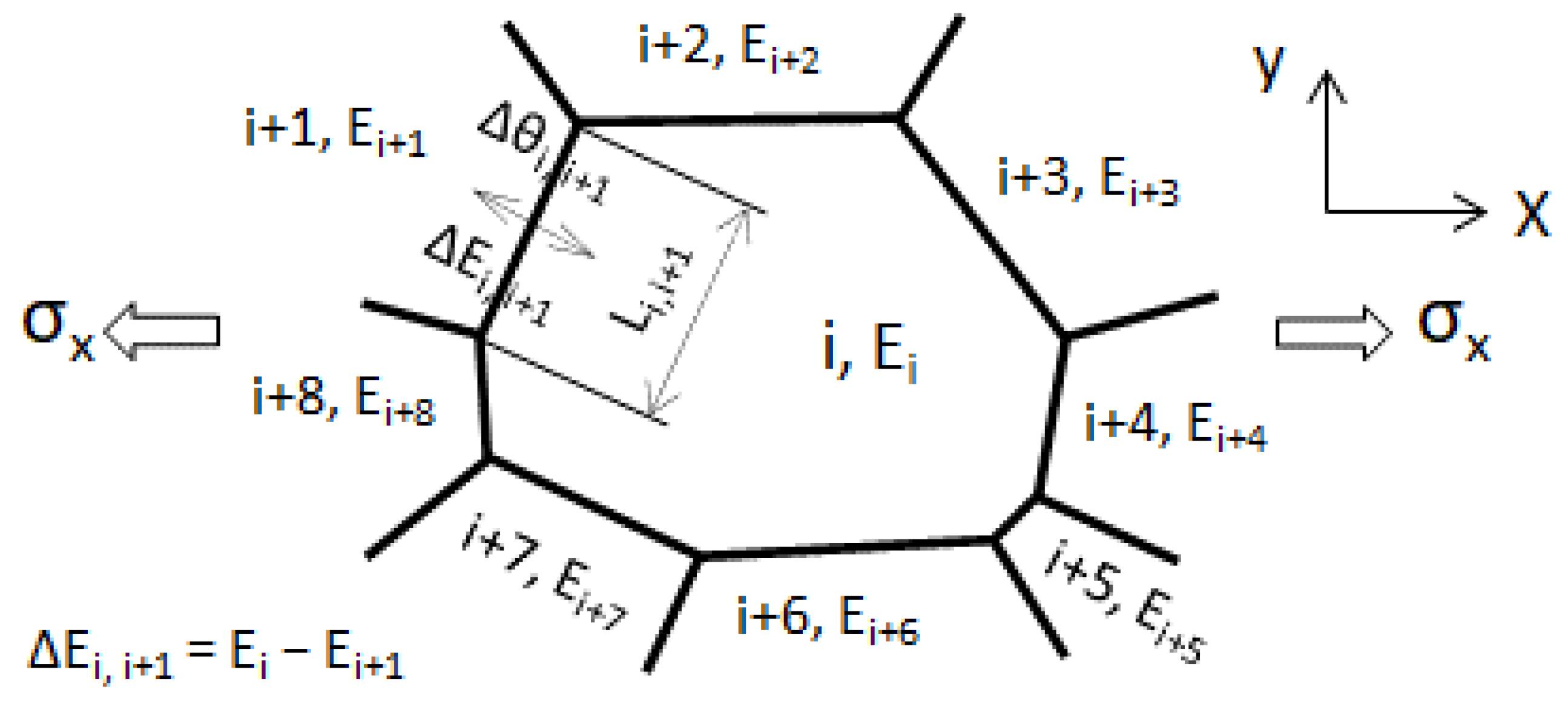
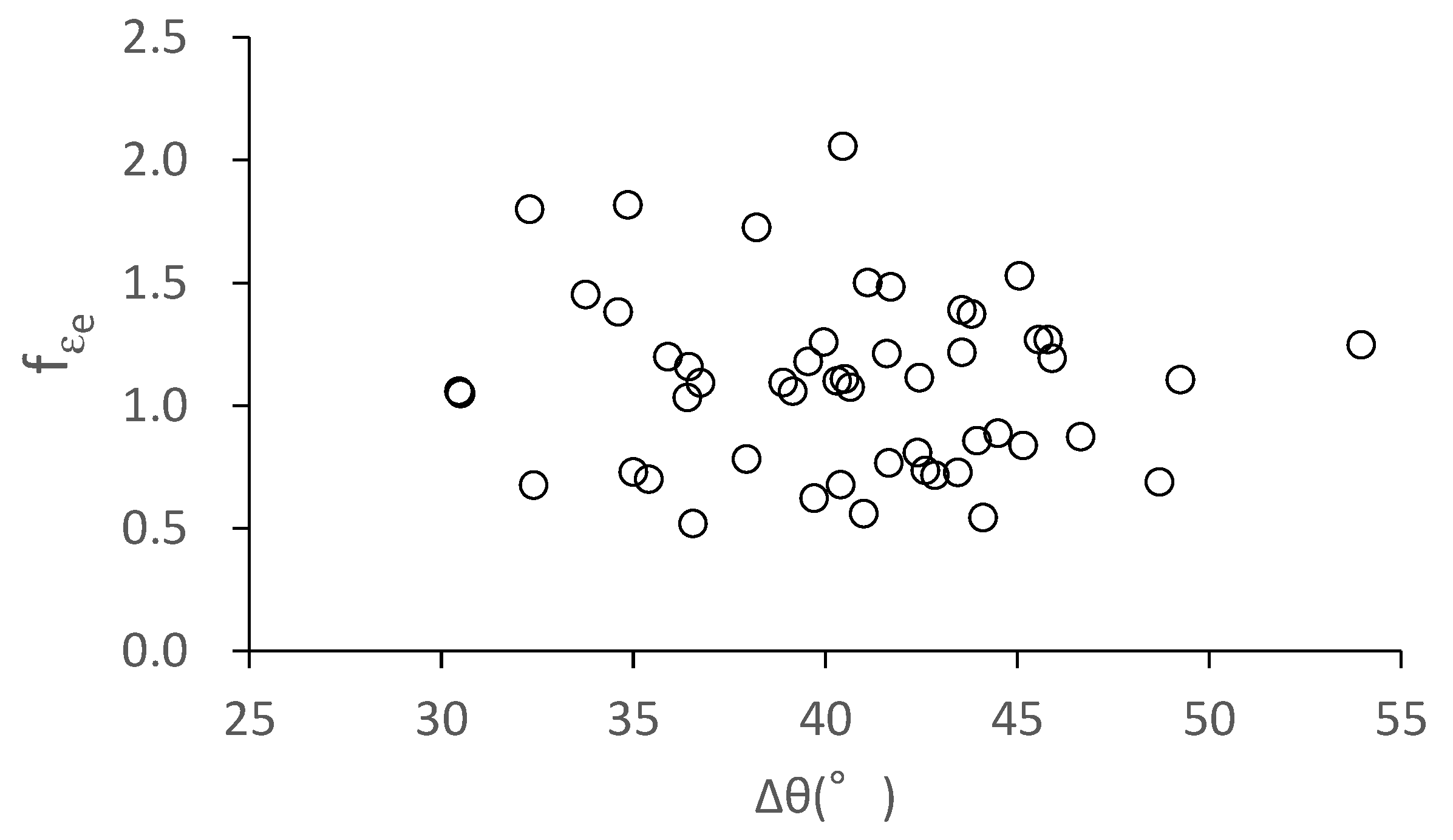

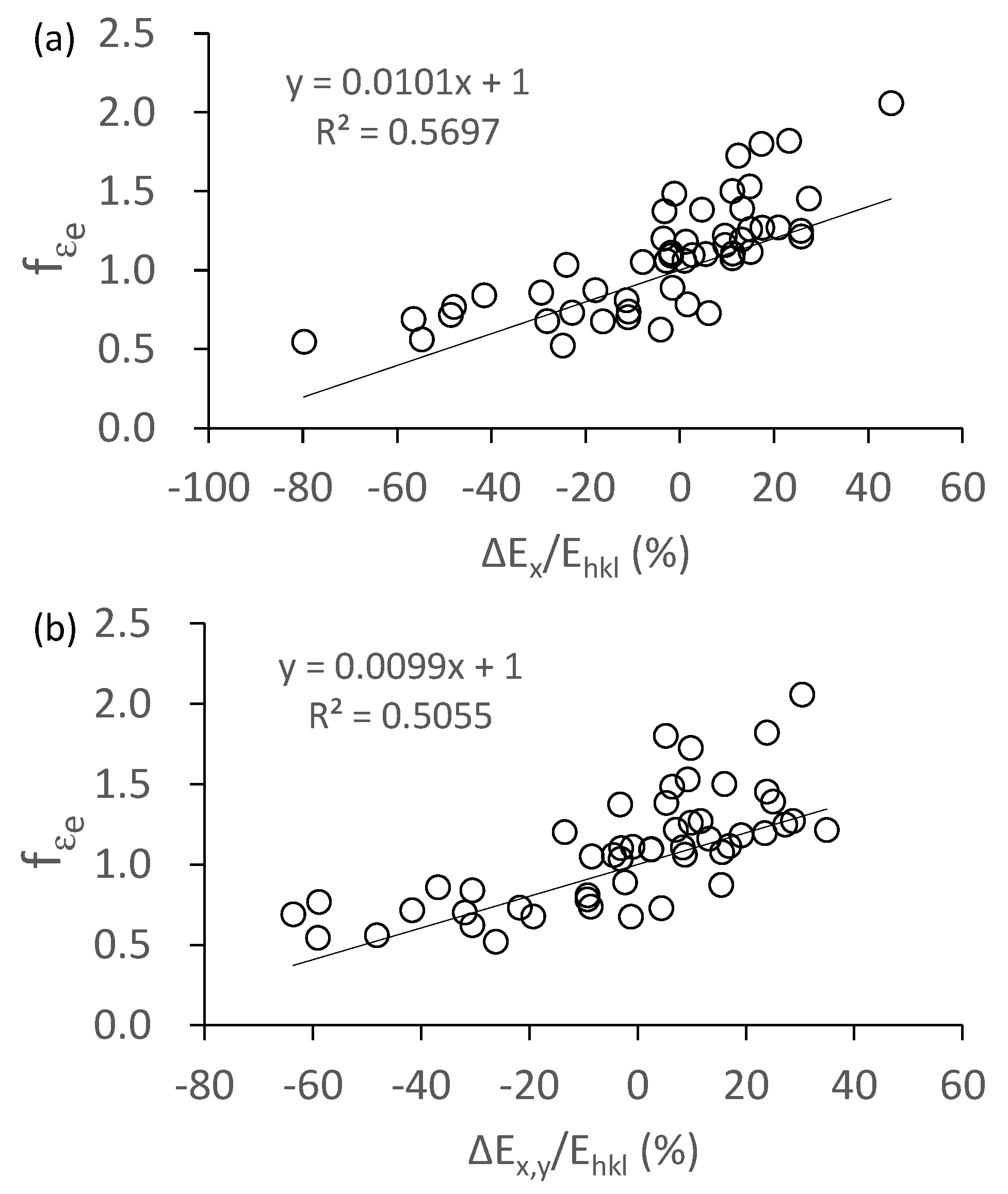
| Grain No. | [hkl] | Ehkl (GPa) | Eexp (GPa) | R2 | fεe | Grain No. | [hkl] | Ehkl (GPa) | Eexp (GPa) | R2 | fεe | ||||
|---|---|---|---|---|---|---|---|---|---|---|---|---|---|---|---|
| 1 | −2 | 5 | 17 | 153 | 209 | 0.6442 | 0.73 | 28 | −7 | −6 | 22 | 168 | - | −2.665 | - |
| 2 | −2 | −3 | 3 | 268 | 147 | 0.8259 | 1.82 | 29 | −2 | 1 | 4 | 190 | 181 | 0.9398 | 1.05 |
| 3 | −7 | 8 | 11 | 260 | 173 | 0.7432 | 1.5 | 30 | 3 | −3 | 8 | 187 | - | −2.109 | - |
| 4 | 5 | 6 | 6 | 279 | 230 | 0.5752 | 1.21 | 31 | −19 | −5 | 26 | 214 | 155 | 0.8856 | 1.38 |
| 5 | 2 | 8 | 25 | 154 | 215 | 0.8725 | 0.72 | 32 | −19 | −5 | 26 | 214 | 202 | 0.8589 | 1.06 |
| 6 | 2 | −3 | 3 | 268 | 130 | 0.7014 | 2.06 | 33 | −8 | −5 | 25 | 161 | 192 | 0.862 | 0.84 |
| 7 | −1 | −3 | 14 | 143 | 262 | 0.4016 | 0.55 | 34 | 1 | −3 | 8 | 163 | 190 | 0.3082 | 0.86 |
| 8 | 5 | 6 | 9 | 246 | 194 | 0.785 | 1.27 | 35 | −6 | −3 | 13 | 183 | 166 | 0.7021 | 1.1 |
| 9 | −11 | −2 | 25 | 170 | 251 | 0.938 | 0.68 | 36 | 6 | −14 | 21 | 215 | 197 | 0.7733 | 1.09 |
| 10 | 1 | −3 | 3 | 236 | 154 | 0.7015 | 1.53 | 37 | 6 | −14 | 21 | 215 | 194 | 0.8963 | 1.11 |
| 11 | 15 | 2 | 17 | 220 | 181 | 0.2365 | 1.22 | 38 | 1 | 2 | 6 | 160 | - | −0.72 | - |
| 12 | 2 | −2 | 15 | 140 | 182 | 0.9673 | 0.77 | 39 | 0 | 2 | 3 | 201 | 167 | 0.6794 | 1.2 |
| 13 | −8 | 1 | 13 | 195 | 268 | 0.5746 | 0.73 | 40 | 4 | −7 | 8 | 252 | 211 | 0.7984 | 1.19 |
| 14 | 9 | −14 | 22 | 226 | 191 | 0.6547 | 1.18 | 41 | −7 | −5 | 9 | 255 | 202 | 0.9573 | 1.26 |
| 15 | −8 | −2 | 9 | 226 | 131 | 0.7602 | 1.73 | 42 | 13 | −12 | 15 | 278 | 191 | 0.9617 | 1.45 |
| 16 | −3 | −11 | 13 | 225 | 125 | 0.9326 | 1.8 | 43 | −1 | −22 | 36 | 194 | 239 | 0.7243 | 0.81 |
| 17 | 1 | −4 | 16 | 146 | 260 | 0.4253 | 0.56 | 44 | −7 | −2 | 22 | 154 | 220 | 0.0831 | 0.7 |
| 18 | 6 | 15 | 20 | 225 | 209 | 0.9326 | 1.08 | 45 | −3 | −1 | 12 | 147 | 235 | 0.1615 | 0.62 |
| 19 | −11 | −4 | 16 | 214 | 156 | 0.7553 | 1.37 | 46 | −9 | 5 | 10 | 252 | 170 | 0.9535 | 1.48 |
| 20 | −1 | −13 | 22 | 191 | 215 | 0.8605 | 0.89 | 47 | −7 | −8 | 8 | 281 | 202 | 0.9903 | 1.39 |
| 21 | 4 | 7 | 10 | 231 | 209 | 0.8757 | 1.11 | 48 | −1 | 10 | 13 | 212 | 205 | 0.9478 | 1.04 |
| 22 | −8 | −10 | 25 | 184 | 249 | 0.9442 | 0.74 | 49 | 14 | −19 | 27 | 245 | 220 | 0.8862 | 1.12 |
| 23 | 1 | 0 | 27 | 133 | 192 | 0.9373 | 0.69 | 50 | 0 | 1 | 1 | 220 | 208 | 0.939 | 1.06 |
| 24 | 9 | −9 | 23 | 191 | 244 | 0.5049 | 0.78 | 51 | 5 | 9 | 14 | 220 | 201 | 0.5511 | 1.1 |
| 25 | 2 | −18 | 25 | 208 | 307 | 0.8213 | 0.68 | 52 | 19 | 1 | 33 | 189 | 216 | 0.9519 | 0.87 |
| 26 | 2 | −5 | 17 | 153 | 293 | 0.4542 | 0.52 | 53 | −19 | 8 | 22 | 237 | 190 | 0.7922 | 1.25 |
| 27 | −12 | 15 | 19 | 263 | 207 | 0.8277 | 1.27 | 54 | −14 | −15 | 25 | 240 | 207 | 0.7853 | 1.16 |
Publisher’s Note: MDPI stays neutral with regard to jurisdictional claims in published maps and institutional affiliations. |
© 2021 by the authors. Licensee MDPI, Basel, Switzerland. This article is an open access article distributed under the terms and conditions of the Creative Commons Attribution (CC BY) license (https://creativecommons.org/licenses/by/4.0/).
Share and Cite
Qiu, H.; Ueji, R.; Kimura, Y.; Inoue, T. Grain-to-Grain Interaction Effect in Polycrystalline Plain Low-Carbon Steel within Elastic Deformation Region. Materials 2021, 14, 1865. https://doi.org/10.3390/ma14081865
Qiu H, Ueji R, Kimura Y, Inoue T. Grain-to-Grain Interaction Effect in Polycrystalline Plain Low-Carbon Steel within Elastic Deformation Region. Materials. 2021; 14(8):1865. https://doi.org/10.3390/ma14081865
Chicago/Turabian StyleQiu, Hai, Rintaro Ueji, Yuuji Kimura, and Tadanobu Inoue. 2021. "Grain-to-Grain Interaction Effect in Polycrystalline Plain Low-Carbon Steel within Elastic Deformation Region" Materials 14, no. 8: 1865. https://doi.org/10.3390/ma14081865
APA StyleQiu, H., Ueji, R., Kimura, Y., & Inoue, T. (2021). Grain-to-Grain Interaction Effect in Polycrystalline Plain Low-Carbon Steel within Elastic Deformation Region. Materials, 14(8), 1865. https://doi.org/10.3390/ma14081865






